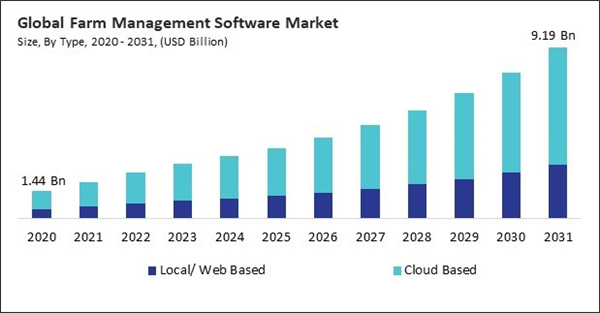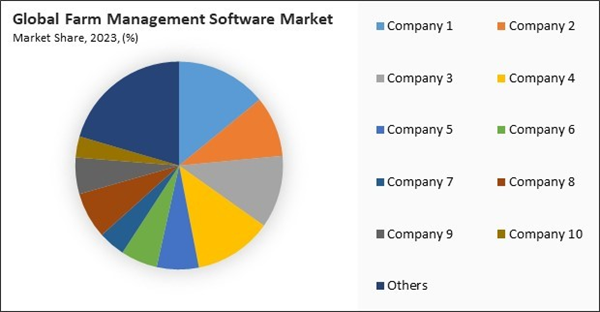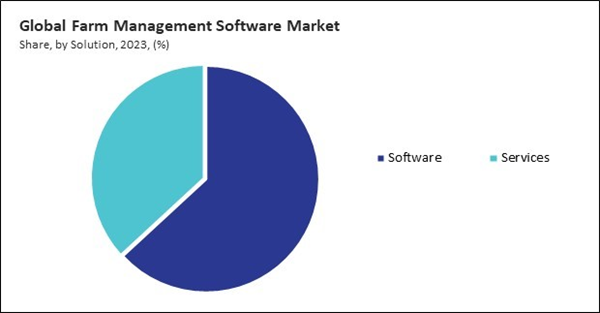The Global Farm Management Software Market size is expected to reach $9.19 billion by 2031, rising at a market growth of 15.7% CAGR during the forecast period.
European farmers are increasingly adopting precision farming solutions, IoT-based monitoring systems, and AI-powered analytics to improve resource efficiency, reduce carbon footprints, and comply with strict agricultural policies. The Common Agricultural Policy (CAP) of the European Union offers incentives and funding to promote the implementation of smart agricultural solutions. Therefore, the Europe segment procured 32% revenue share in the market in 2023. Additionally, the rising concerns over food security, climate change, and efficient land use have propelled investments in automated irrigation, smart greenhouses, and remote sensing technologies, making Europe a key market for farm management software.
Beyond productivity, animal welfare is another crucial aspect driving the adoption of digital livestock management solutions. Wearable health monitoring devices equipped with biometric sensors track vital parameters such as heart rate, body temperature, and stress levels, enabling early detection of diseases and reducing livestock mortality rates. These tools help minimize antibiotic usage, ensure compliance with organic and sustainable farming standards, and improve the overall well-being of animals. Additionally, as global food demand surges, precision farming is no longer a luxury but an urgent necessity. By integrating technology-driven agricultural practices, farmers, particularly smallholders, can increase food production sustainably, ensuring that the world’s growing population is adequately fed. The adoption of precision agriculture technologies is essential for enhancing food security, improving farm profitability, and ensuring environmental sustainability, making it a critical component of the future of global agriculture. Hence, the market is on the brink of a significant transformation in agriculture as the demand for precision farming solutions increases.
However, farmers face training and technical support expenses. Many of these digital solutions have a steep learning curve, necessitating specialized training for farm operators and workers. Hiring experts or subscribing to technical support services can add recurring costs, making the long-term affordability of these solutions another pressing concern. Without financial aid, subsidies, or cost-effective solutions, many farmers hesitate to invest in such technologies, slowing the adoption of smart farming practices. Hence, these factors may hamper the growth of the market.
The leading players in the market are competing with diverse innovative offerings to remain competitive in the market. The above illustration shows the percentage of revenue shared by some of the leading companies in the market. The leading players of the market are adopting various strategies in order to cater demand coming from the different industries. The key developmental strategies in the market are Acquisitions, and Partnerships & Collaborations.
European farmers are increasingly adopting precision farming solutions, IoT-based monitoring systems, and AI-powered analytics to improve resource efficiency, reduce carbon footprints, and comply with strict agricultural policies. The Common Agricultural Policy (CAP) of the European Union offers incentives and funding to promote the implementation of smart agricultural solutions. Therefore, the Europe segment procured 32% revenue share in the market in 2023. Additionally, the rising concerns over food security, climate change, and efficient land use have propelled investments in automated irrigation, smart greenhouses, and remote sensing technologies, making Europe a key market for farm management software.
Beyond productivity, animal welfare is another crucial aspect driving the adoption of digital livestock management solutions. Wearable health monitoring devices equipped with biometric sensors track vital parameters such as heart rate, body temperature, and stress levels, enabling early detection of diseases and reducing livestock mortality rates. These tools help minimize antibiotic usage, ensure compliance with organic and sustainable farming standards, and improve the overall well-being of animals. Additionally, as global food demand surges, precision farming is no longer a luxury but an urgent necessity. By integrating technology-driven agricultural practices, farmers, particularly smallholders, can increase food production sustainably, ensuring that the world’s growing population is adequately fed. The adoption of precision agriculture technologies is essential for enhancing food security, improving farm profitability, and ensuring environmental sustainability, making it a critical component of the future of global agriculture. Hence, the market is on the brink of a significant transformation in agriculture as the demand for precision farming solutions increases.
However, farmers face training and technical support expenses. Many of these digital solutions have a steep learning curve, necessitating specialized training for farm operators and workers. Hiring experts or subscribing to technical support services can add recurring costs, making the long-term affordability of these solutions another pressing concern. Without financial aid, subsidies, or cost-effective solutions, many farmers hesitate to invest in such technologies, slowing the adoption of smart farming practices. Hence, these factors may hamper the growth of the market.
The leading players in the market are competing with diverse innovative offerings to remain competitive in the market. The above illustration shows the percentage of revenue shared by some of the leading companies in the market. The leading players of the market are adopting various strategies in order to cater demand coming from the different industries. The key developmental strategies in the market are Acquisitions, and Partnerships & Collaborations.
Driving and Restraining Factors
Drivers
- Rising Demand for Precision Agriculture
- Growing Number of Government Initiatives and Subsidies
- Adoption of Livestock and Dairy Management Solutions
Restraints
- High Initial Investment and Implementation Costs
- Limited Digital Literacy Among Farmers
Opportunities
- Increasing Demand for Food Security and Sustainability
- Growth in Agribusiness Investments
Challenges
- Lack of Standardization & Interoperability
- Data Privacy & Security Concerns
Deployment Model Outlook
Based on deployment model, the market is bifurcated into local/web based and cloud based. The cloud based segment garnered 68% revenue share in the market in 2023. The increasing adoption of precision agriculture, remote farm monitoring, and AI-driven analytics has driven demand for cloud-based platforms. These solutions allow farmers to access real-time farm data from any location, collaborate with multiple stakeholders, and integrate IoT devices efficiently. Additionally, cloud-based farm management software offers cost-effective subscription models, reducing the need for heavy upfront investments in IT infrastructure.Cloud Based Outlook
On the basis of cloud based type, the market is classified into SaaS and PaaS. The SaaS segment acquired 73% revenue share in the market in 2023. SaaS solutions allow users to subscribe to farm management tools with minimal upfront investment, making them particularly attractive for small and medium-sized farms. These platforms typically include real-time farm monitoring, automated reporting, weather analytics, and precision agriculture support, enabling farmers to optimize resources and increase productivity. Additionally, continuous software updates, seamless scalability, and compatibility with IoT devices have contributed to the widespread adoption of SaaS-based farm management solutions.Solution Outlook
By solution, the market is divided into software and services. The services segment garnered 37% revenue share in the market in 2023. The services segment is motivated by the necessity of system integration, expert support, and training to enable farmers to effectively utilize farm management software. Many farmers, especially in developing regions, lack technical expertise in operating advanced digital tools, creating a strong demand for consulting, training, and troubleshooting services. The increasing complexity of farm management solutions, which integrate AI, IoT, and big data analytics, has led to a rise in customization and implementation services to ensure seamless adoption.Service Type Outlook
Based on services type, the market is segmented into system integration & consulting, maintenance & support, managed services, and assisted professional services. The system integration & consulting segment procured 32% revenue share in the market in 2023. As more farmers adopt AI-driven analytics, smart irrigation systems, and drone-based monitoring, the demand for customized software solutions and expert consulting services has surged. Large agribusinesses and commercial farms require tailored solutions that align with their specific operational needs, leading to increased investments in integration services. Government initiatives promoting digital agricultural transformation have also encouraged training programs and consultancy services to help farmers transition from traditional to data-driven farming methods.Application Outlook
On the basis of application, the market is classified into precision farming, livestock monitoring, smart greenhouse, aquaculture, and others. The precision farming segment recorded 37% revenue share in the market in 2023. Precision farming enables real-time monitoring of soil conditions, crop health, weather forecasts, and irrigation needs, allowing farmers to optimize resource utilization and maximize yields. The increasing focus on reducing agricultural waste, improving sustainability, and boosting productivity has accelerated the use of farm management software in precision farming.Regional Outlook
Region-wise, the market is analyzed across North America, Europe, Asia Pacific, and LAMEA. The North America segment garnered 36% revenue share in the market in 2023. The widespread use of IoT, AI, and cloud-based farm management platforms has enabled farmers to enhance productivity through real-time data analytics, automated machinery, and GPS-based monitoring. Additionally, government initiatives, subsidies, and research programs supporting digital transformation in agriculture have accelerated adoption.Recent Strategies Deployed in the Market
- Sep-2023: Affectiva, a Smart Eye company, introduced an enhanced attention metric in its cloud-based Emotion AI, leveraging Smart Eye's advanced eye-tracking technology. This provides precise insights for brands, advertisers, and market researchers. This distinctive and thorough measurement analyzes gaze and head position, providing unmatched precision and valuable insights.
- Jun-2023: Smart Eye A/S signed an agreement with Linde, the world’s largest industrial gas company, to enhance safety in linde's gas distribution heavy vehicles. Initially, the AIS system will be installed in Linde's heavy vehicles in the Nordic and Baltic countries following a comprehensive evaluation and testing process.
- Dec-2021: Smart Eye A/S completed the acquisition of iMotions, the developer of the world’s leading software platform for studying human behavior. This integration has offered a comprehensive, multi-modal analysis of complex human behaviors in diverse environments, primarily focusing on Human Insights AI in the automotive industry. By integrating iMotions' Behavioral Research Suite, Smart Eye aimed to synthesize data from over 50 biosensors and explicit measures into a unified research platform, providing deeper insights into human behaviors across various markets.
- Jul-2020: Realeyes OU developed an emotion analysis service under the collaboration with NEC Corporation, a Japanese multinational information technology and electronics corporation, merging NEC's biometric and video analytics with Realeyes' technology. This service analyzes user emotions through facial expressions on video communication tools with full consent and privacy considerations.
- Apr-2020: Realeyes OU has unveiled its latest facial coding technology, utilizing front-facing cameras, computer vision, and machine learning to detect attention and emotion in opt-in audiences watching video content. Additionally, the upgraded classification system promises customers more precise and sensitive insights into the emotional impact of their videos.
List of Key Companies Profiled
- Trimble, Inc.
- CropZilla Software, Inc.
- Raven Industries, Inc.
- Deere & Company
- Iteris, Inc.
- DuPont de Nemours, Inc.
- Gamaya
- Bayer AG
- CropX, Inc.
- Cropin Technology Solutions Private Limited
Market Report Segmentation
By Deployment Model
- Local/ Web Based
- Cloud Based
- SaaS
- PaaS
By Solution
- Software
- Services
- System integration & Consulting
- Maintenance & Support
- Managed services
- Assisted professional services
By Application
- Precision Farming
- Livestock Monitoring
- Smart Greenhouse
- Aquaculture
- Other Application
By Geography
- North America
- US
- Canada
- Mexico
- Rest of North America
- Europe
- Germany
- UK
- France
- Russia
- Spain
- Italy
- Rest of Europe
- Asia Pacific
- China
- Japan
- India
- South Korea
- Singapore
- Malaysia
- Rest of Asia Pacific
- LAMEA
- Brazil
- Argentina
- UAE
- Saudi Arabia
- South Africa
- Nigeria
- Rest of LAMEA
Table of Contents
Chapter 1. Market Scope & Methodology
Chapter 2. Market at a Glance
Chapter 3. Market Overview
Chapter 4. Competition Analysis - Global
Chapter 5. Global Farm Management Software Market by Deployment Model
Chapter 6. Global Farm Management Software Market by Solution
Chapter 7. Global Farm Management Software Market by Application
Chapter 8. Global Farm Management Software Market by Region
Chapter 9. Company Profiles
Companies Mentioned
- Trimble, Inc.
- CropZilla Software, Inc.
- Raven Industries, Inc.
- Deere & Company
- Iteris, Inc.
- DuPont de Nemours, Inc.
- Gamaya
- Bayer AG
- CropX, Inc.
- Cropin Technology Solutions Private Limited
Methodology

LOADING...











